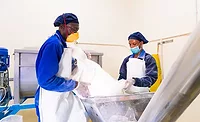Can the Food Microbiome Help Us Ensure Safety and Quality? An Exploration

Credit: Roxiller/iStock / Getty Images Plus via Getty Images
You have probably heard of the human gut microbiome and its importance to our health. But what about the microbiome of foods? Similar to the gut microbiome, foods have a diverse community of indigenous or native microbes that reside on a food product that are acquired from its environment during harvest, processing, and storage.
This community can be made up of both "good" and "bad" bacteria. "Good" bacteria like lactic acid bacteria (LAB) could potentially provide benefits to the microbial safety of the food. "Bad" bacteria, like pathogenic organisms such as Listeria monocytogenes or Escherichia coli, can be detrimental to human health. The food microbiome is dynamic, influenced by changes in temperature, salinity, pH, oxygen, and exposure to other organisms, resulting in shifts in the bacterial population proportions. These dynamics can be further influenced by adding new bacteria—or bacteria already present in greater proportions—to help influence and improve food safety and quality.
Utilizing the Food Microbiome
Pathogenic bacteria are evolving to develop resistances against commonly used chemical sanitation strategies. This, in combination with a consumer-driven desire for more natural, clean-label alternatives to process and preserve food, has highlighted the need to look to alternative methodologies to ensure the microbial safety of food. The use of the native food microbiome as a protective tool to improve safety provides a valuable alternative mitigation strategy without relying on chemical treatments to reduce foodborne illness.
One way to utilize the food microbiome would be through the implementation of competitive exclusion (CE) during the food production process. The CE approach works by utilizing one bacterium to inactivate another. One approach to this method is to add "good" bacteria from the food microbiome in greater proportions during food processing, thus outcompeting pathogenic bacteria for nutrients or physical space and preventing it from populating.
Alternatively, a second strategy would be to use bacteria that produce beneficial byproducts, such as antimicrobial or antifungal activity to inhibit the growth of other bacteria. 1 LAB, for example, can produce lactic acid, bacteriocins, and other inhibitory metabolites, which can be added to foods during processing to help inhibit the growth of foodborne pathogens.2
A wide variety of foods can be great sources for isolating beneficial bacteria like LABs to use in CE approaches. The microbiome of raw fruits and vegetables are largely made up of Lactobacilli due to their high sugar content.3 Other foods like dairy products are hosts to predominately Enterococcus, Lactococcus, Pediococcus, and Leuconostoc populations. Organisms like Carnobacterium, Lactococcus, Leuconostoc, and Pediococcus genus are examples of LAB that have been isolated from food products and now have Generally Recognized as Safe (GRAS) status through the U.S. Food and Drug Administration (FDA).4
Looking for quick answers on food safety topics?
Try Ask FSM, our new smart AI search tool.
Ask FSM →
Outcompeting Pathogens
Ready-to eat (RTE) products could particularly benefit from the utilization of foodborne LABs in food safety efforts. RTE foods can become contaminated with foodborne pathogens like L. monocytogenes after the lethality step during processing. L. monocytogenes is resilient to many common preservation methods like acidic treatments, refrigeration, and salt stress. While heat treatments are an effective way to reduce L. monocytogenes, the exposure to heat can affect the quality of the product after production.5 Therefore, an alternative solution is needed to reduce the presence of foodborne pathogens following processing without compromising the integrity of the product. The CE approach provides an alternative mitigation strategy that actively works to prevent the growth of pathogenic bacteria like L. monocytogenes during manufacturing.
The CE method has been shown to be effective in both RTE meat and dairy products. Meat and dairy tend to have robust native microbiological niches consisting of many different LAB due to fermentation. Isolates from these products have been tested against L. monocytogenes during challenge studies, which have supported it as a potentially effective strategy. The use Latilactobacillus sakei or Pediococcus acidlactici—common LABs that naturally occur on meat products—were shown to reduce L. monocytogenes levels (2–3-log CFU/g) when applied to chorizo and salami products during processing.6,7 Other studies using strains of L. sakei, L. brevis, L. plantarum, L. lactis, and E. faecalis were able to reduce Listeria by 2–4 log CFU/g in cheeses when added during the ripening or storage phase of cheese production.8,9
The Future of Food Safety and Quality?
Future work is looking to leverage the microbiome of food to predict and shape the quality and safety of foods. The use of high-throughput sequencing with total DNA or RNA could help monitor shifts in a microbial community to indicate a problem with food quality or safety. For example, spoilage organisms like Carnobacterium spp. or Leuconostoc spp. present in higher proportions than normal could indicate problems with food quality and safety.
Alternately, detection of foodborne pathogens in the microbiome could indicate a problem with food safety. There have been attempts to monitor the microbiome using total DNA or RNA of foods during processing and storage. However, this technique has limitations. The indigenous microflora, comprising mainly innocuous bacteria, can inhibit the ability to detect foodborne pathogens that typically occur at very low abundance compared to the resident microflora.10 This would make it difficult to detect the pathogen's DNA even if it were present. This technique, for the time being, might be better suited to monitor food quality.
As pathogens adapt, we too must adapt to establish new and competitive solutions to reduce the risk of foodborne illnesses. Using the native food microbiome as a protective mechanism provides a way to utilize bacteria in a positive way to ensure food safety and quality.
- Crowley. S, J. Mahony, and D. van Sinderen. "Current perspectives on antifungal lactic acid bacteria as natural bio-preservatives." Trends in Food Science & Technology 33, no. 2 (2013): 93–109.
- Lee, S. J., H. S. Jeon, J. Y. Yoo, and J. H. Kim. "Some important metabolites produced by lactic acid bacteria originated from kimchi." Foods 10, no. 9 (2021).
- Khubber, S., F. J. Marti-Quijal, I. Tomasevic, F. Remize, and F. J. Barba. "Lactic acid fermentation as a useful strategy to recover antimicrobial and antioxidant compounds from food and by-products." Current Opinion in Food Science 43 (2022): 189–198.
- U.S. FDA. "Microorganisms & Microbial-Derived Ingredients Used in Food." January 4, 2018. https://www.fda.gov/food/generally-recognized-safe-gras/microorganisms-microbial-derived-ingredients-used-food-partial-list.
- Webb, L., L. Ma, and X. Li. "Impact of lactic acid bacteria on the control of Listeria monocytogenes in ready-to-eat foods." Food Quality and Safety 6 (2022).
- Ortiz, S., V. Lopez, M. Garriga, and J. V. Martinez-Suarez. "Antilisteral effect of two bioprotective cultures in a model system of Iberian chorizo fermentation." International Journal of Food Science & Technology 49, no. 3 (2014): 753–758.
- Vaz-Velho, M., S. Jacomea, L. Noronhab, et al. "Comparison of antilisteral effects of two strains of lactic acid bacteria during processing and storage of a Portuguese salami-like product 'Alheira'." Chemical Engineering 32 (2013).
- Campagnollo, F. B., L. P. Margalho, B. A. Lamimura, et al. "Selection of indigenous lactic acid bacteria presenting anti-listerial activity and their role in reducing the maturation period and assuring the safety of traditional Brazilian cheeses." Food Microbiology 73 (2018): 288–297.
- Pisano, M. B., M. E. Fadda, S. Viale, M. Deplano, F. Mereu, M. Blazic, and S. Cosentino. "Inhibitory effect of Lactiplantibacillus plantarum and Lactococcus lactis autochtonous strains against Listeria monocytogenes in a laboratory cheese model." Foods 11, no. 5 (2022): 715.
- Jarvis, K. G., N. Daquigan, J. R. White, et al. "Microbiome associated with foods from plant and animal sources." Frontiers Microbiology 9 (2018): 2540.








.webp?t=1721343192)
